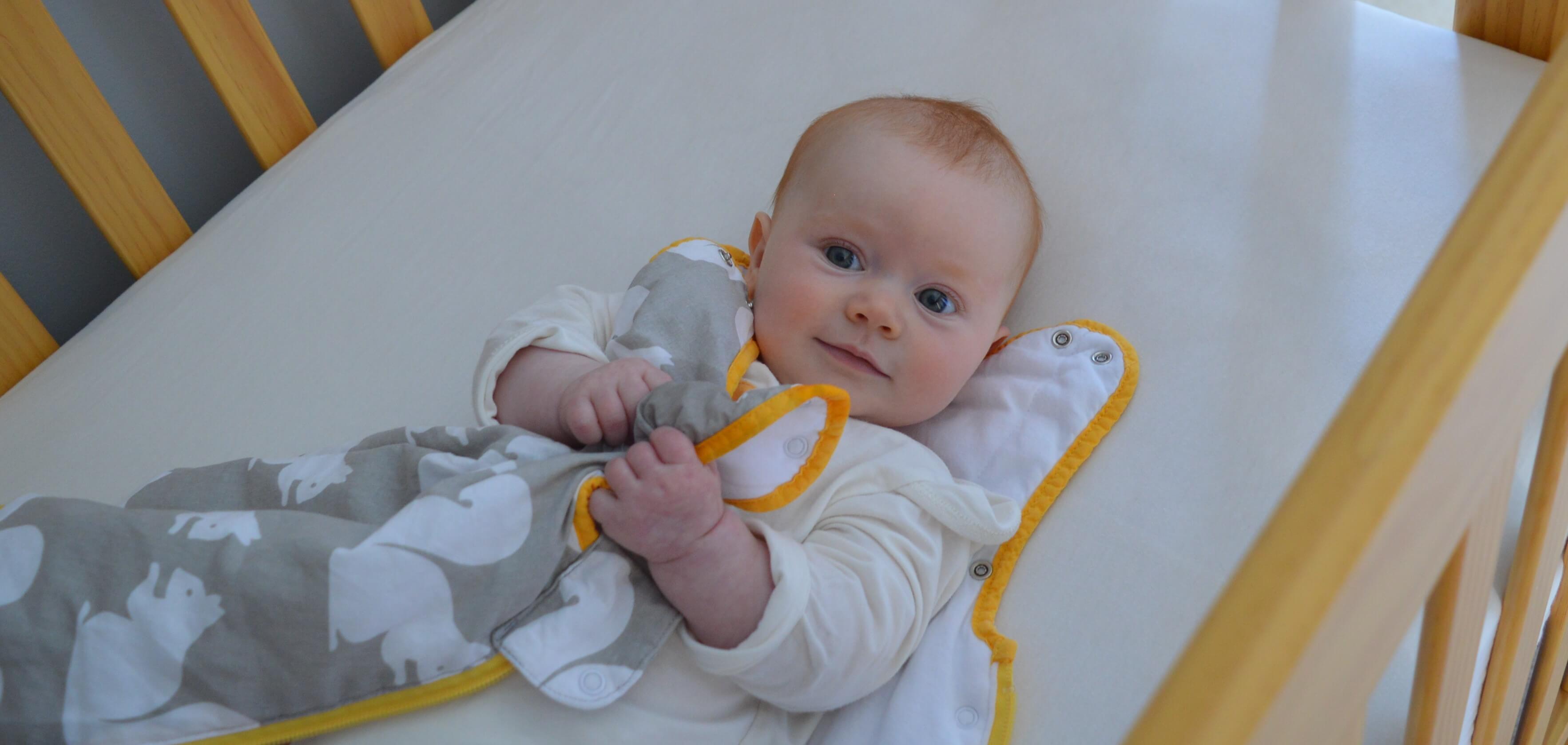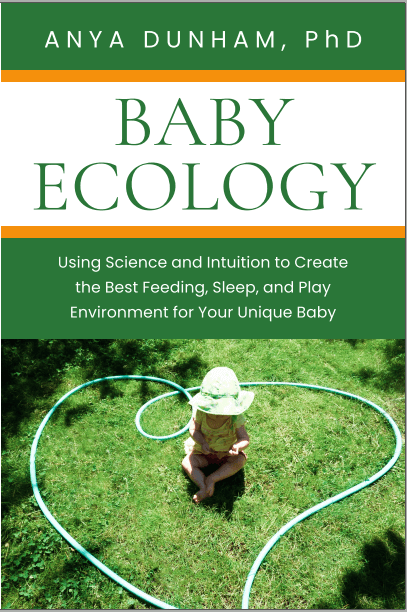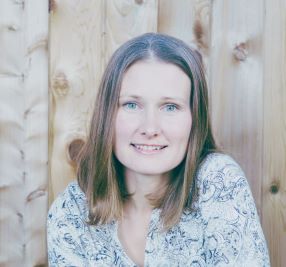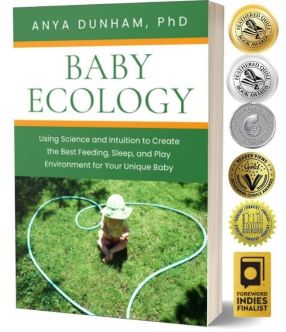Baby Ecology book is here! Learn more
Baby Ecology book is here!
- Home
- Getting Ready Checklist
- Science-based baby facts
10 neat (and useful) baby facts
by Anya Dunham, PhD
These baby facts are based on science - and come with practical takeaways to help you care for your baby.

You have probably seen a few “fun baby facts” lists, with things like “babies are born without kneecaps”.
(Which is not entirely true: babies do have kneecaps, but they are made of cartilage and not yet hardened into bony kneecaps older children and adults have!)
This list is going to be a little different. In 800+ peer-reviewed scientific publications I read in the process of writing my book, Baby Ecology, I discovered 10 lesser-known baby facts that are actually useful for everyday baby care.
Whether you are getting ready to welcome your baby, have a newborn, or an older baby, take a look.
Here are the 10 baby facts, with main takeaways highlighted in green!
10 baby facts
1. Babies learn like scientists, by figuring out patterns and noticing surprising events. Their brains constantly make mental maps: “When I see this happen, I can expect that.” They also look for surprises that don’t fit into the patterns they learned previously.1 For example, by about 5 months babies learn that objects that are dropped usually fall down2 and may be surprised to see a balloon floating in the air. ⇝ Takeaway: This is an extra reason to create routines. Your baby is experiencing new things all the time; even his body is constantly changing as he grows and learns new skills. But with daily routines around meal times, bedtime, and bath time, he will recognize the familiar steps, be able to predict what comes next, and feel safer and calmer.
2. Babies as young as 2 months old can anticipate, and even help with, familiar actions. When adults approach babies in a way that is slow and clearly visible, babies adjust their posture to help with the smoothness of the pickup: they focus on the adult’s face, tense their neck and back muscles, and open their arms a little wider, creating space for the adult’s hands3. ⇝ Takeaway: From birth, invite your baby to participate in routines – such as being picked up or having her diaper changed – by slowing down, showing and telling her what you are about to do, and practicing mind-mindedness.
3. Babies’ sleep structure matures by 3 to 4 months – and there’s no built-in biological improvement in sleep after that.4 Sleeping longer stretches becomes possible when babies begin going back to sleep on their own after wakings, smoothly connecting their sleep cycles. ⇝ Takeaway: Whether you bed-share or your baby sleeps on her own, help your baby sleep better by guiding him towards self-settling while being responsive and giving him predictable opportunities for naps.
4. Babies’ biological clocks are pre-set for waking up early (unfortunate baby fact for all of us night owls, I know!..). A study looked at sleep of almost 30,000 babies and toddlers living in 17 different countries. Although typical bedtimes varied greatly — from 7:30 p.m. in New Zealand to 10:20 p.m. in Hong Kong — children in all countries woke early, generally between 6 and 8 am, and it was bedtime that determined the length of their night sleep.5 In other words, a baby who goes to sleep late will likely get fewer hours of night sleep and miss some of the deep sleep that typically happens in the evening hours. ⇝ Takeaway: Help your baby get the sleep she needs by keeping an early bedtime.
5. Introducing solids does not help babies sleep better. Babies who receive more milk and solids during the day are less likely to feed at night, but are just as likely to wake up.6 A baby doesn’t wake up because she’s hungry; rather, she wakes up naturally between sleep cycles and may or may not be hungry. ⇝ Takeaway: Remember that introducing solids is unlikely to bring longer stretches of sleep, so don’t rush it for that reason: wait till your baby is ready. Guide your baby towards self-settling so he goes back to sleep unless his need to eat is greater than his need to sleep. When he is hungry, he will let you know, and you will not need to guess.
6. Teething itself doesn’t cause high fever or major sleep disruptions.7-10 Because many babies show some of these symptoms around “tooth days,” and because babies continue to get new teeth over many months starting around the middle of their first year, teething often becomes a scapegoat for many physical symptoms, fussiness, or sleep issues. ⇝ Takeaway: If your baby has a fever or loose stools, don’t assume it’s “just teething”: see your baby’s health care practitioner to rule out illness.
7. Babies can regulate how much they eat depending on food’s nutritional density. Breastfed babies are able to feed according to appetite from birth, consume exactly what they need, and, by doing so, establish and maintain mom’s milk supply.11,12 Bottle-fed babies also know how much to drink and are able to consistently signal when they are full.13-15 Once babies begin eating solids, they, again, know how much to eat. (Read about remarkable pioneering research from the 1920s where babies thrived on diets they chose themselves!). ⇝ Takeaway: Create a supportive feeding environment and then trust your baby to eat as much as she needs.
8. Babies may need 8 or more tastes of new food before they become used to the new flavour. 16,17 These need to be actual bites (not just seeing or playing with the food), in different meals and in a supportive, no-pressure setting. In one study, when offered an initially disliked vegetable over 8 subsequent meals, most babies learned to like it as much as their favourite vegetable; 9 months later, they still liked it!17 ⇝ Takeaway: Although your baby may initially dislike some of the foods she tries or spit them out, continue offering her a variety of nutrient-dense options: iron-rich meats and legumes, healthy fats, vegetables and fruits. One of the best ways to create a supportive feeding environment is to eat with your baby, family-style.
9. Babies are captivated by screens, but all they see is a blur. A 5-month-old can hear the sounds and see what’s happening on screen almost as well as her parents; she can recognize simple shapes. But all she’s experiencing is an overstimulating stream of flashing lights and colours with no apparent connection to each other, to the sounds she hears, or to the people and objects in her life. She will not begin comprehending the show’s content or even sequences of events until she is at least 18 months old.18,19 ⇝ Takeaway: Don’t introduce screen time during your baby’s first year; consider limiting background TV.
10. Babies cannot easily shift their gaze to the side like adults and older kids: to really look at and fully notice something, they need to align their torso, head, and eyes and turn toward the object.20 Being able to see something they hear or smell helps babies with sensory integration as it allows engaging multiple senses in a coordinated way (for example, hear barking and see the dog at the same time). Because of this, babies benefit from being in positions that let them move freely and don’t limit their visual field. ⇝ Takeaway: Give your baby plenty of opportunities for free movement and exploration; consider creating a 100% safe play area and being mindful of time spent in “baby containers”.
Neat, isn’t it? My main takeaway from the studies I read is that our babies come into the world ready to connect and learn. And we, parents and caregivers, can support them by proactively creating the environments where they can thrive, instead of looking for techniques to solve 'problems' later on.
Learn more about these and other surprising baby facts in my book, Baby Ecology.
You might also be interested in:
References
References
1. Marcus GF et al (1999) Rule learning by seven-month-old infants. Science 283(5398): 77-80
2. Needham A, Baillargeon R (1993) Intuitions about support in 4.5-month-old infants. Cognition 47(2): 121-148
3. Reddy V, Markova G, & Wallot S (2013). Anticipatory adjustments to being picked up in infancy. PLoS ONE 8(6): e65289
4. Jenni O, Carskadon M (2000) Normal human sleep at different ages: infants to adolescents. Pp 11-19 in: SRS Basics of Sleep Guide, Sleep Research Society, Westchester, IL, USA
5. Mindell JA et al (2010) Cross-cultural differences in infant and toddler sleep. Sleep Medicine 11(3): 274-280
6. Brown A, Harries V (2015) Infant sleep and night feeding patterns during later infancy: association with breastfeeding frequency, daytime complementary food intake, and infant weight. Breastfeeding Medicine 10(5): 246-252
7. Wake M, Hesketh K, Lucas J (2000) Teething and tooth eruption in infants: a cohort study. Pediatrics 106(6): 1374-1379
8. Markman L (2009) Teething: facts and fiction. Pediatrics in Review 30(8): e59-e64
9. Ramos-Jorge J et al (2011) Prospective longitudinal study of signs and symptoms associated with primary tooth eruption. Pediatrics 128(3): 471-476
10. Memarpour M, Soltanimehr E, Eskandarian T (2015) Signs and symptoms associated with primary tooth eruption: a clinical trial of nonpharmacological remedies. BMC Oral Health 15(88)
11. Dewey KG, Lönnerdal B (1986) Infant self-regulation of breast milk intake. Acta Paediatrica 75(6): 893-898
12. Kent JC et al (2006) Volume and frequency of breastfeedings and fat content of breast milk throughout the day. Pediatrics 117(3): e387-e395
13. Ventura AK, Beauchamp GK, Mennella JA (2012) Infant regulation of intake: the effect of free glutamate content in infant formulas. The American Journal of Clinical Nutrition 95(4): 875-881
14.Ventura AK, Inamdar LB, Mennella JA (2015) Consistency in infants' behavioural signalling of satiation during bottle-feeding. Pediatric Obesity 10(3): 180-187
15. Ventura AK, Mennella JA (2017) An experimental approach to study individual differences in infants' intake and satiation behaviors during bottle-feeding. Childhood Obesity 13(1): 44-52
16. Nicklaus S (2011) Children's acceptance of new foods at weaning. Role of practices of weaning and of food sensory properties. Appetite 57(3): 812-825
17. Maier A et al (2007) Effects of repeated exposure on acceptance of initially disliked vegetables in 7-month old infants. Food Quality and Preference 18(8): 1023-1032
18. Anderson DR, Pempek TA (2005) Television and very young children. American Behavioral Scientist 48(5): 505-522
19. Anderson DR, Hanson KG (2010) From blooming, buzzing confusion to media literacy: the early development of television viewing. Developmental Review 30(2): 239-255
20. Bambach S et al (2016) Objects in the center: how the infant’s body constrains infant scenes. Pp 132-137 in: Proceedings of the Joint IEEE International Conference on Development and Learning and Epigenetic Robotics
Using hundreds of scientific studies, Baby Ecology connects the dots to help you create the best environment for sleep, feeding, care, and play for your baby.
Warmly,
Anya


